How To Get More Black Friday Sales: Top Marketing Strategies
2024-11-01
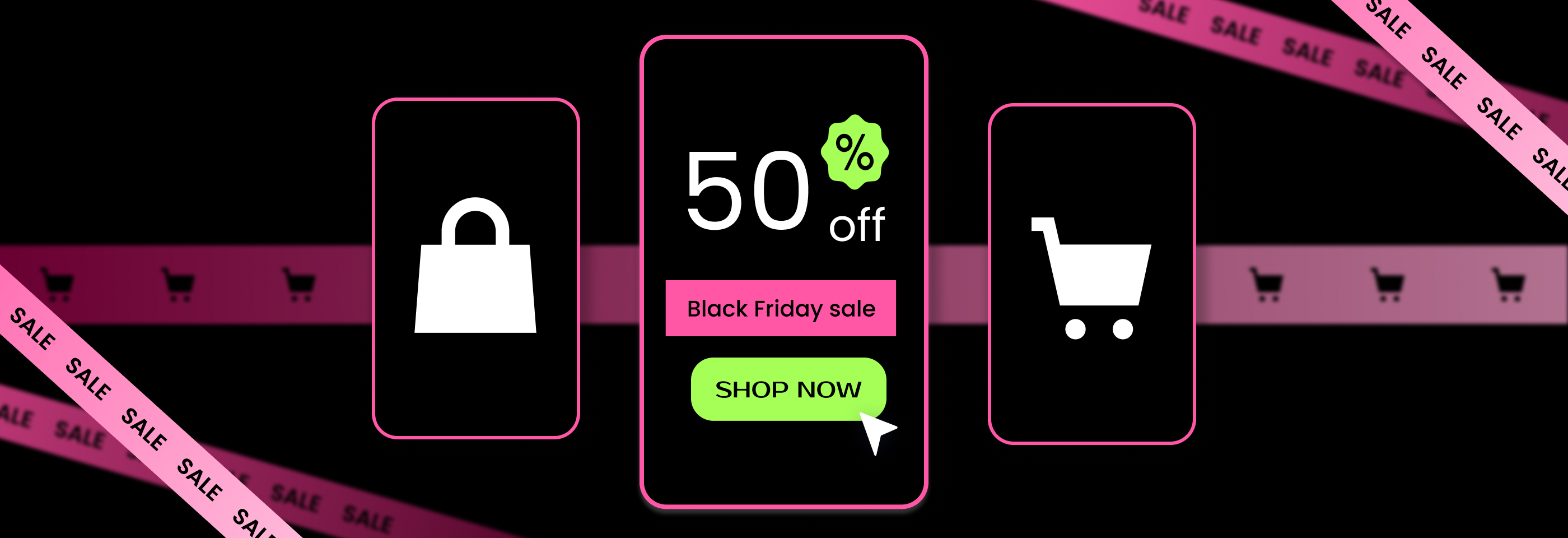
As the holiday season approaches, we’re also getting closer to Black Friday and Cyber Monday – two of the biggest shopping events of the year.
Often lumped together and simply called ‘BFCM’, Black Friday and Cyber Monday bring some of the best chances of the year to boost sales and find new customers for all types of businesses.
In this guide, we’ll go over how to get the most out of BFCM, get noticed, connect with new and loyal customers, and make this holiday season a huge success for your business.
Black Friday, Cyber Monday: what’s the deal?
Black Friday and Cyber Monday (often lumped together under the ‘BFCM’ acronym) are huge shopping events that happen every year as a part of the ‘Cyber Weekend’ – time when businesses sell their products with huge discounts.
In the US, Black Friday always falls on the post-Thanksgiving Friday, and Cyber Monday comes on the next Monday after that. The dates can be different in other parts of the world, but the point is still the same. And every year, these shopping events just keep getting bigger.
Just take a look at the data: in 2023, Black Friday sales hit $9.8 billion in the United States, and some analysts predict that consumers will spend even more this year on both Black Friday and Cyber Monday. Basically, the revenue from both events continues to grow year over year.
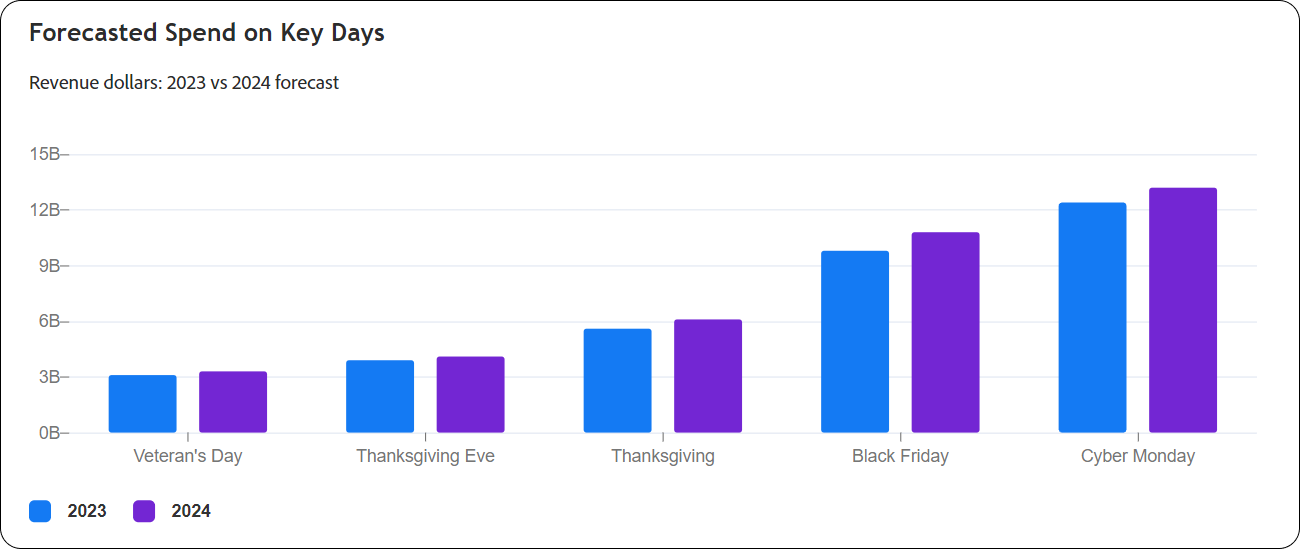
Source: Adobe
This makes it a big opportunity for brands. Consider just these reasons why your business needs to participate in the BFCM event:
- Growing brand awareness: Black Friday and Cyber Monday are the ideal times to introduce your brand to new shoppers. Many people spend the weekend looking for fresh brands and deals, so a strong marketing campaign can help you stand out and attract new customers and start building relationships with them.
- Higher sales potential: customers are ready to spend during BFCM (especially when it comes to buying gifts for upcoming holidays), making it the perfect time for businesses to see a big revenue boost.
- More online shoppers: these days bring in massive online traffic, which means that you can reach tons of new customers and turn that extra traffic into real sales if you work on your online presence.
- Opportunity to clear out old stock: BFCM is also a great opportunity to move excess inventory with discounts and bundle deals.
But as always, with great opportunities comes high competition. What’s more, it’s not enough to just slap a discount on random products and call it a day. This usually leads to customers being dissatisfied with what they bought under the influence of FOMO: statistics show that only less than a third of consumers find BFCM sales worth it.

Source: Finder
To stand out, businesses need to plan early, grow their customer lists, and be prepared with a solid strategy. Let’s see how to do all of that.
Planning for Black Friday and Cyber Monday
As BFCM happens at the end of November, late October-early November is the last chance to properly prepare and start running your sales campaigns.
Let’s consider one common strategy many businesses use to prepare for BFCM.
Pre-BFCM: Lay the groundwork
Preparation is everything when it comes to Black Friday and Cyber Monday success. During this stage, you need to dive into the data you already have on your customers, identify the needs of the core segments you want to reach, and identify your top-performing products throughout the year that can satisfy those needs.
Next comes the execution part: you need to start working on your campaigns and prepare to launch them in time. Here are some things you can do during this step:
1. Build anticipation
It’s important to not just present your offers to potential customers but make them look forward to and anticipate them – you want to create a sense of excitement and then satisfy it with good deals.
The best time to start creating excitement about your upcoming sales comes long before BFCM arrives – think of this phase as warming up your audience. In general, you want to start generating buzz in September-October and launch your main marketing and advertising campaigns a week or two before Thanksgiving to let everyone know about your deals and offers.
But this is just a rough timeline that should be adjusted to the specifics of your industry, products, and audience. For example, Walmart starts Black Friday sales on November 11th this year, with other big corporations also starting early. You don’t want to be too late, but you also don’t want to be too early, so analyze the situation, check on your competitors, and choose the right schedule for your campaigns.
Then, you can do the following to generate anticipation:
- Running lead-generation ads, creating a lead-generation landing page or popup form: you can ask people to sign up to your newsletter and collect user information in exchange for early access to good deals.
- Sending out emails offering your top deals to the early birds. Creating a sense of exclusivity really helps to make people look forward to your sales.
- Creating teasers on your social media with hints at exclusive deals.
Every interaction during this preparatory step helps you build a list of the most interested shoppers ready to jump in when the sales go live. You’ll be able to use it to retarget these people and take them all the way through your sales funnel.
2. Coordinate all of your marketing channels
Another important step is to sync up your online and in-store promotions to give your audience the best experience across all channels.
While many consumers prefer to shop online these days, there’s still a considerable foot traffic to physical stores. If you have offline locations, you need to make sure all of your promotions are aligned and that customers are aware of the benefits of shopping both online and offline.
For example, you can prepare a “Buy Online, Pick-Up In-Store” (BOPIS) option to help drive foot traffic and give your customers flexibility. It’s also a great way to cut expenses on delivery for both you and the customers – in other words, a win-win solution.
The same goes for aligning all of your online promotion channels: your website, social media, search engines, email, etc. Offers should be consistent across all channels and lead to specific landing pages on your website – this helps consumers avoid confusion and find the right deals for their needs.
You can also benefit from creating a marketing or advertising calendar: it will help you plan when to execute each part of your campaign, keep everything consistent, and stay in touch with your audience before, during, and after your sales events.
3. Optimize for mobile
Roughly a half of consumers make purchases using their phones, which means that your website, content, and ads should be optimized for mobile.
For example, this could mean making the checkout process on your website smooth and fast-loading, offering opportunities to shop without leaving social media platforms (like on Facebook or Instagram Shop), making it easy to search for different item categories on the mobile version of your website, and so on.
This could also look like tailoring your marketing and advertising campaigns for mobile viewing: using short-form videos, simple but attention-grabbing graphics, concise copies, etc.
Basically, the planning phase is all about getting organized so that you can hit the ground running and prepare for what comes next.
During BFCM: Connect and convince
When Black Friday and Cyber Monday are finally here, your focus should be on creating urgency. Your goal here is to encourage action by reminding customers of limited-time offers and showing the most popular items at the forefront of your campaign.
Words and visuals should create that "don’t miss out" feeling to push visitors to act fast. Eye-catching banners, countdowns, graphics on your website, emails, social media, etc. – all of this can add to the urgency.
With increased online traffic during Black Friday and Cyber Monday, you also have to make sure your website or app can take it, and that your checkout is running smoothly. Don’t forget to regularly check site speed, loading times, and interactive elements. Another thing you can implement are chatbots: use them to quickly answer common questions and speed up the process.
Well-timed email and SMS reminders can be powerful as well: they keep your brand fresh in customers’ minds and nudge undecided shoppers to buy.
Finally, personalize wherever possible. You can use customer data to suggest products or bundles based on what people seem to be interested in, give personalized recommendations, and promote targeted upsells at checkout to drive extra sales and boost average order value, and so on. If you’re consistently collecting insights about your audience (and don’t stop at the pre-Black Friday stage), you’ll be able to keep everything tailored to what each customer needs exactly.
After BFCM: Keep the sales going and analyze the results
Even after Black Friday and Cyber Monday end, you don’t have to lose momentum – lots of customers are still in shopping mode, wrapping up holiday gifts, or looking for extended deals.
You can keep the excitement going by offering last-minute discounts for a few days post-BFCM to catch late shoppers who missed out over the weekend. You could also highlight any leftover stock with deals or create “holiday bundles” using products that didn’t sell as fast – this is a great way to clear out your inventory and give your customers a chance to get a good deal after Cyber Weekend is over.
If you have a loyalty program, it’s also a great time to thank customers for their purchases with a little reward. A thank-you email with a small discount or bonus points for their next order will make them feel appreciated and more likely to buy from you again.
Finally, when things quiet down, take some time to review your results. Look over your sales data and campaign performance to see which products, ads, and channels did best. Gathering feedback through a quick survey or social media poll can also give you useful insights to get even better results next year.
Top Black Friday and Cyber Monday marketing and advertising strategies
1. Use countdowns
Countdowns are the best way to remind people about the upcoming sale and build anticipation. By starting a countdown a week or two before the big day, you can keep your brand top of your customers’ minds.
Example strategy:
Start your countdown 1-2 weeks before Black Friday. Each day, post a countdown graphic with engaging visuals and a caption hinting at exclusive deals. Use Stories on Facebook and Instagram to provide daily reminders with a unique theme, such as "3 days to go – Here’s a sneak peek!" This will build anticipation and position your brand as a must-visit for Black Friday.
 Countdowns in emails, ads, or on your website help people make the purchasing decision faster.
Countdowns in emails, ads, or on your website help people make the purchasing decision faster.
You can experiment with SMS and email reminders as well, but don’t overdo it. A well-timed reminder, like "Only 1 day left! Get ready for the sale of the season," keeps your audience interested without being too pushy.
2. Spotlight your best sellers
Putting your best-selling products at the center of attention before Black Friday is another effective way to build trust and excitement. People want to know they’re buying not just something popular but also well-loved (= well-reviewed), and featuring these products in your Black Friday or Cyber Weekend offers will seal the deal for many customers. Paired with the reviews and other forms of social proof, your offers will be irresistible. This will also show your audience that they’ll be getting quality items, not just clearance.
Example strategy:
Create individual posts or a carousel for social media and landing pages to show your top products or categories through high-quality visuals. For each product, highlight unique features, customer reviews, quality certifications, and other information that acts as an incentive to buy.
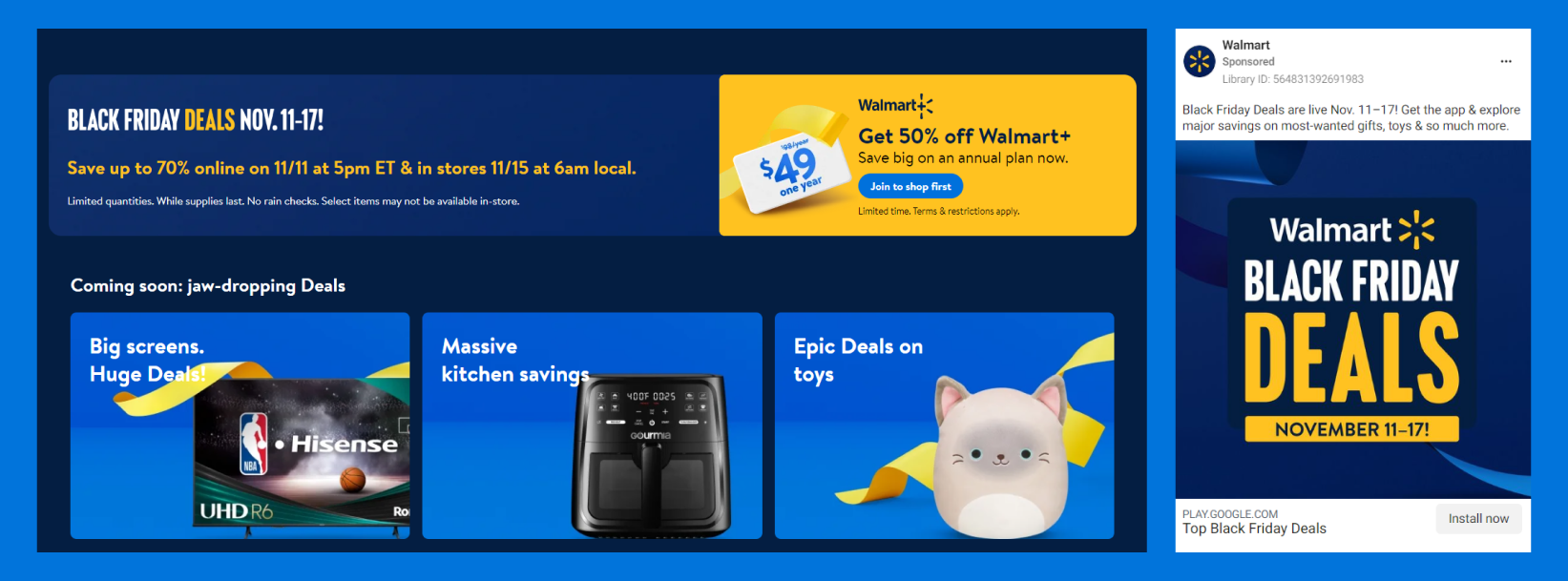
Show your most popular product categories or items to help people make the right choice.
Another tactic is to mention that these products will be on limited-time offers during Black Friday: use phrases that appeal to FOMO (like “Don’t miss out” or “Get ready to buy these favorites at unbelievable prices!”) to make people look forward to your sale.
3. Show Behind-the-Scenes prep
Letting customers see the preparation behind the scenes gives a personal touch to your brand. You can show the stockroom, packing orders, or setting up displays: this “insider” content adds transparency and personality to your brand and makes customers feel more excited for what’s to come.
Example strategy:
Show the warehouse stocking shelves, packaging items, or your marketing team brainstorming campaign ideas. Use Stories or “day in the life" Reels to show followers what goes into making the Cyber Weekend sale possible.
Always keep it genuine – people love seeing a brand’s personality when it’s authentic and doesn’t come across as forced. So, follow your brand’s communication style and tone that your audience is already used to (which doesn’t mean you can’t freshen or lighten it up a bit!).
4. Run polls to gauge interest in specific products
Running polls helps you see which products people want to see on sale and are looking forward to buying. You can do polls practically on all marketing channels: on social media, in email, on your website, and so on – it’s a very convenient tool for getting insights into customers’ preferences.
This can help you gain information on what products to prioritize, potentially boosting the success of your Black Friday offerings. Polls also help customers feel that they’re part of the decision-making process and that your business is there to satisfy their needs.
Example strategy:
Poll your followers on Instagram or Facebook or email newsletter subscribers by asking which category of products they’d love to see on sale. Share the results in a follow-up post or story to drive up engagement.
You can make it more fun by asking humorous questions, using attractive visuals, and engaging with your audience directly (e.g., in the comments). Use responses to tailor your promotional content and create personalized offers for different audience segments.
5. Create gift guides
A lot of people are buying gifts for their loved ones during BFCM: after all, Christmas, New Year, and other holidays are just around the corner, and what’s the best time to get gifts for everyone than during the biggest sale of the year?
Curated gift guides can make shopping easier for your customers, and you can tailor these guides to different types of shoppers and gift receivers. “Gifts for Him/Her”, “Gifts Under $50/100/200”, etc. – there are many gift guide ideas you can use and tailor to your customers.
Example strategy:
Create visually organized, themed guides for easy navigation. Use different categories to break down the offers by price, gift receivers, type of gift, etc. Share your guides with your social media followers and email subscribers with direct links to each product. You can also add some product bundles for a “Gift for All” option and highlight how convenient these bundles are as a one-stop solution for gift-giving.
6. Offer exclusive deals
Giving your followers, loyalty program members, email subscribers, etc., exclusive discount codes or offers shows them your appreciation for their loyalty. This little token of appreciation can be a big incentive for people to shop.
Another way to capitalize on the sense of exclusivity is to give out surprise discount codes to keep followers engaged and checking back frequently. You can also offer the first X purchasers an extra gift, discount, or a deal.

Early BFCM deals attract shoppers that don't want to miss out.
Flash deals and discounts throughout the day is also a great tactic to motivate quick purchases, especially when paired with a countdown timer (think something like “60 minutes only!” or “Only until midnight!”).
Example strategy:
Share an exclusive discount code just for your social media followers. This can be done as a surprise with a flash code that stays active for a short time only. You can use captions like “Here’s a treat just for you” or add an inside joke that only your most loyal followers will get.
You can also give early access to Black Friday deals to people from your loyalty program or email list, thanking them for loyalty and incentivizing others to join in. CTAs that say something like “Sign up to shop before everyone else” can help with that.
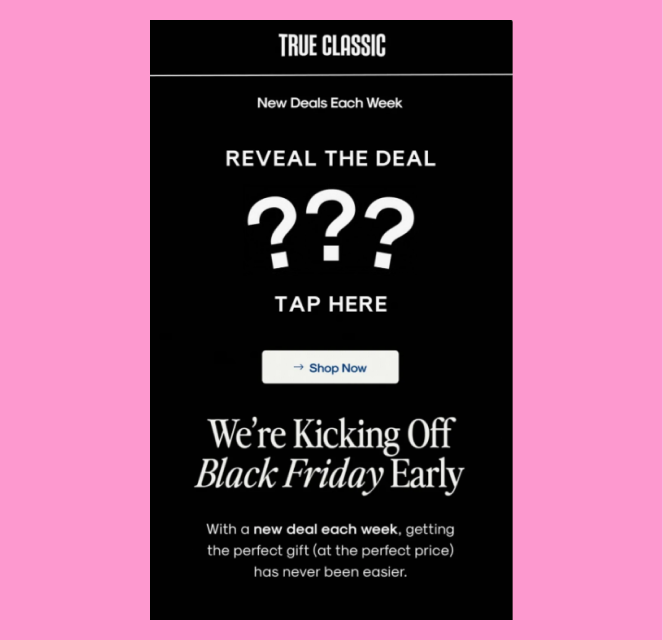 Elements of surprise and gamification turn discounts and deals into something much more interesting.
Elements of surprise and gamification turn discounts and deals into something much more interesting.
Use Instagram or Facebook Stories to add beautiful visuals to your offers and gamify the experience – only the most attentive viewers will see the discount code or the time when it drops! You can also turn your discount code into an answer to a riddle to make it even more fun for your followers.
7. Show proof
How do you convince a doubting customer that your products are worth it? The best way to do so is to show concrete proof of it – this can be customer reviews, ratings, user-generated content (UGC), and so on.
You can display all the information that helps people make a decision on product pages on your website, in your ads, content, email newsletters, etc. Seeing the positive experiences of other people helps build trust and nudges new customers towards buying.
Example strategy:
Choose customer testimonials that talk about the main product benefits and address common concerns (like durability, quality, price, repair guarantees, etc.), and then include them in your ads, content, and emails, or simply post them on your website in a specific section.
For an interactive touch, feature live reviews or tag customers who share your products, turning them into brand ambassadors. You can also create social media cards with quotes or photos from happy customers who love your products.
8. Highlight current trends
With Black Friday and Cyber Weekend in general being such a huge event, keeping people up to date on your most popular and trendy items can make a big difference.
If you’re aware of trending products or seasonal favorites, highlight them as “must-haves” to let customers see that your brand is in sync with what’s hot right now. This makes it easy for trend-conscious shoppers to justify their purchases since they’re getting what’s “in” for the season.
Example strategy:
Research trending products or styles within your industry and share how your brand is on top of these trends. Position your products as the perfect trendy (but valuable!) gift, connecting them with current fashion or tech trends. Hint: use social media to find out what people talk about, and then go to Google to check if the trends translate to real supply and demand.
Another way to show how your products fit in within the current trends is to collaborate with trend-focused influencers. Even a simple “collaboration” post where the influencer highlights a product can increase your brand’s visibility and add credibility.
9. Personalize offers
You can make shopping more personal by suggesting items based on what customers have already bought or checked out – this makes it a lot easier for them to make the decision.
Dynamic ads on various advertising platforms (both social media and search engines) that adjust based on their interests keep people engaged and increase the chances they’ll find something they love. Plus, mentioning past purchases or mentioning the types of products your customers are interested in in emails or ads makes the experience feel even more personal.
Example strategy:
Set up retargeting ads to show customers similar items to those they've browsed or products that pair well with what they’ve already bought. For emails, try personalized subject lines like “Recommended for You” or “Handpicked Just for You” to create curiosity and encourage clicks.
You can make things even more special by addressing each customer by name and incorporating their recent shopping history.
10. Target high-intent and last-minute shoppers
Catching the attention of last-minute shoppers is a must during Black Friday and Cyber Monday. Many people make quick decisions, so sending reminder emails or texts right before and during the sale can help close the deal. You can highlight low stock and quick shipping to let people know that now’s the best time to buy.
Example strategy:
Segment your list to target those who’ve shown interest but haven’t bought yet, and send them emails or show ads with a reminder like “Last Chance for Black Friday Deals!”.
Include a “one-click buy” option or pre-filled cart link in reminder emails or retargeting ads. This makes it simple for last-minute shoppers to check out with minimal hassle.
11. Let people know about your payment and shipping options
Offering flexible payment and shipping options can be a big draw during Black Friday and Cyber Monday – often, that’s what it takes to convince doubtful shoppers.
Options like free shipping and easy returns help customers feel more confident in making a purchase, and options like Buy Now, Pay Later (BNPL) make it easier for them to shop without paying everything upfront – a popular choice, especially for pricier items.
Example strategy:
Highlight these benefits across all customer touchpoints – your homepage, product pages, social media posts, and emails. Simple banners with messages like “Free Shipping & Easy Returns” or “Shop Now, Pay Later” remind shoppers that they’re getting extra value and flexibility when they buy from you.
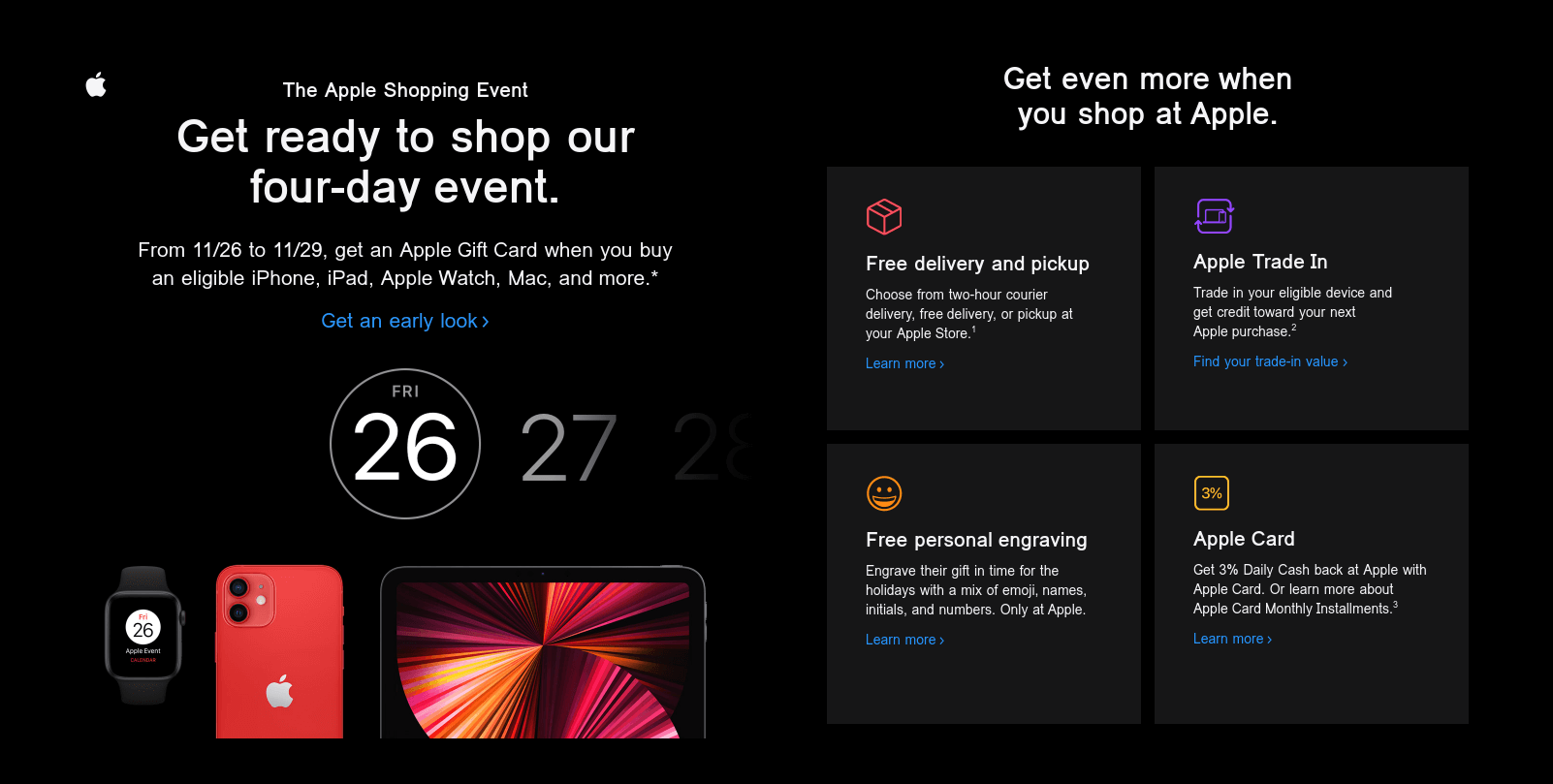
Make the additional perks of buying your products visible to seal the deal.
Show customers how close they are to reaching the free shipping threshold at checkout to encourage spending a bit more. Also, consider highlighting return policies right beside your BNPL and free shipping options so shoppers know they’re covered if they need to exchange or return items.
Another trick is to promote free shipping in ads targeting last-minute shoppers to seal the deal for undecided buyers.
Tips to manage your Black Friday and Cyber Monday campaigns
Getting the best results for Black Friday and Cyber Monday (BFCM) takes planning and a few key tactics. Here’s how to set up your campaigns to get the most out of them:
1. Budget wisely
Effective BFCM budgeting requires both pre-planning and real-time management. One common strategy is to allocate more budget toward the days before Black Friday, since people often start browsing deals early. This way, you can capture their attention before the main event.
On Black Friday itself, you can increase budgets for well-performing campaigns, whether its advertising, content, or email. Don’t forget to save some budget for Cyber Monday as well: many online shoppers will be out hunting for the final deals.
To get the most out of your Black Friday or Cyber Monday sales campaigns, create a detailed budget breakdown that aligns with your campaign objectives and target ROI but still allows for flexibility. This will make it easier to adjust as you go and get better results.
2. Leverage native optimization tools
If you’re running advertising and marketing campaigns as a part of your BFCM strategy, take full advantage of the native tools on your platforms of choice.
For example, if you’re running ads on Meta (Facebook and Instagram), you can experiment with the Advantage Campaign Budget (formerly CBO) to automatically shift more budget to your best-performing ads, so you’ll get more for your money without having to constantly check in.
With automatic placements on Meta, Google, and other top advertising platforms, your ads will show up in the spots where they’ll perform best. If you use dynamic ads, their creatives will be adjusted based on what products each person has already checked out, which increases the chances of conversion.
Your email campaigns can also benefit from native optimization tools. For example, email marketing platforms like Mailchimp, Klaviyo, and ActiveCampaign can help you automate email sequences based on what customers do (like leaving items in their cart or browsing certain products), sending reminders that match their interests.
You can also personalize emails by segmenting your audience, so each group gets content that speaks to them, boosting engagement. And with built-in A/B testing, you can try out different subject lines, send times, and content to see what gets the best response from shoppers.
These tools help you capture and retain customer interest with minimal manual intervention, which is crucial in high-traffic periods like BFCM. Learn what native tools the platforms you’re using have, and pick which ones suit your needs the most.
3. Automate campaign management
Automation can make it a lot easier to keep your campaigns performing well, especially when you have a lot of things to manage during BFCM.
For your ad campaigns, use automated rules: they help you react quickly to changes in ad performance and keep things running smoothly. You can set up rules to increase budgets for high-performing ads or pause underperforming ads based on your KPIs, making it easier to quickly scale your campaigns and reach more customers without sacrificing your ROI.
If you’re running Facebook or Instagram ads, check out our previous articles to see how to optimize your ad spend with automated rules or automation strategies.
For emails, you can automate your campaign flows for consistent and timely communication: create a sequence of cart abandonment reminders, and set up a welcome email flow to offer discounts to new subscribers. Automated countdown emails for limited-time deals on Cyber Monday can also drive urgency without requiring hands-on management throughout the weekend.
4. Track and improve for optimal performance
Keeping track of the key performance metrics is essential for the success of your Cyber Weekend campaigns.
For your ad campaigns, focus on key metrics like ROAS, CPC, and conversion rates to identify which ads are driving the best results. For email campaigns, monitor open and click-through rates in real-time to adjust your approach if needed.
Once BFCM wraps up, it’s time to do a post-event analysis of campaign data. Examine top-selling products, ads with the highest engagement, and your best-performing emails to understand what worked and what could be improved. This review process gives you valuable insights to run better campaigns in the future based on your audience’s actual preferences.
Recap
To wrap things up, nailing your Black Friday and Cyber Monday campaigns takes some smart planning and the right tools.
Make sure you budget wisely, use automation for your ads and emails, and keep an eye on performance to connect with your customers and boost those sales. Once the rush is over, take a moment to review your data so you can refine your strategies for next year.
If you’re looking for more tips on upping your holiday marketing game, check out these fall marketing tips. With these strategies, you’ll be set to meet your customers’ needs and make the most of the holiday season!

